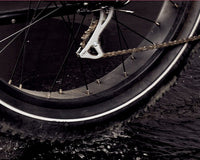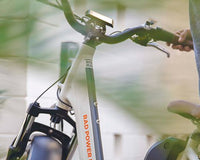Have you ever spent the entire day looking forward to an ebike ride, only to discover that the weather report is predicting rain right when you were planning on hitting the trail?
Don’t worry. A rainy day doesn’t mean you need to take a raincheck — especially when you follow this simple guide for riding your electric bike in the rain.
You Can Ride an Ebike in the Rain
First things first: Yes you can use an electric bike while it’s raining. That answers one of the most frequent questions we hear from would-be riders.
While electric bikes aren't 100% waterproof and can be damaged in heavy storms or intense rain, high-quality ebikes keep their electrical components encased in weather-resistant material that prevents these parts from being directly exposed to the elements.
As a result, riding an ebike in the rain can be similar to riding a traditional, non-electric bike on wet days. Some riders even find it more enjoyable since pedal-assist makes it easier to get back home if the weather take a turn for the worse.
Riding in the rain, however, does require a few more things to consider than fair-weather rides, which we’ll cover here.
What You Should Do:
Ride Responsibly
Just because your ebike can hit 20 MPH doesn’t mean you should always travel that fast.
Slow down to give yourself and those around you more time to react. If you suddenly come across slick roads or other difficult conditions, you’ll be better prepared to meet them. Avoid riding on wet metal, ice, leaves, or other particularly slippery surfaces, and brake earlier since it will take longer to slow down than when conditions are dry. Take more time at intersections to stop and look both ways. If you're on a narrow street and notice a light behind you, consider pulling over and letting that car pass.
Planning the right route is also a great defensive measure. Go where cars are expecting you: bike lanes, bike paths, and other frequently cycled areas. The last thing you want is for a car to whip around the corner and be surprised that you're there.
See and Be Seen

Rainy weather can affect visibility, so it’s important to keep your ebike’s headlight and rear light on to signal to others that you’re on the road. Make sure you check that they’re both clean, functional, visible, and secure before each ride. To maximize your safety, consider applying additional reflective items to your ebike.
Dressing yourself in brightly colored, eye-catching clothing, like a fluorescent jacket or a bright helmet, can also help keep you visible.
A study from the University of Clemson shows that if you're really hoping to be seen, you should go with reflective pants or leggings as well. Drivers are hardwired to notice motion on the road and when you're pedaling, your legs are moving. With that in mind, if your lower body is covered in reflective material, you have a significantly better chance of standing out.
For more visibility tips, check out our guide to riding in the dark.
Dress for Success
In addition to reflective or bright clothing, make sure your outfit is weather-appropriate.
Try a jacket with Velcro cuffs to keep a watertight seal around your wrists. Rain pants are key too, and it's best to go oversized so that when you pedal, the pants don't lift over the opening in your shoe and dump water down your ankles. Don’t go too baggy, though, as you could risk getting fabric caught in the drivetrain.
The most important item you can wear, however, is a bike helmet. While you should never hop on your ebike without one, riding in wet conditions makes it all the more important. In fact, when used properly, this one little accessory is 85-88 percent effective in protecting your head.
Equip your Ebike with Fenders
If your ebike doesn’t come standard with fenders, purchase a pair and install them before riding in the rain.
This is an important step that can keep wet leaves or other gunk on the road from splashing up and getting caught in your ebike.
As an added bonus, fenders will also help keep your pants clean and dry too. Cold liquid can get heavy and start to pull heat away from your body.
Maintain Your Chain
It’s always wise to ensure your bike chain is well-lubricated, but it’s even more important during the rainy season.
There are typically two options for lubricant: dry and wet. Dry lubricant is great during the sunny summer months, but if you’re in an area that’s expecting sustained rainfall, switch to a wet lube that’ll complement the conditions.
If you need help picking the best option for your area and the time of year, ask a local, reputable bike shop for their recommendation.
There's no set timeline for how often you should lube your chain. It really depends on how often you ride and the weather in your area. When there's more exposure to water, your ebike will likely require more TLC.
Need help lubing your bike chain? We can show you how to do it right.
Store Your Ebike in a Dry Space
After your ride, make sure to lock up your ebike in a dry area away from the elements, like inside a garage, shed, or your home. Dry it with a clean, dry cloth and make sure to keep it stored upright. Your ebike is designed for the rain to flow off of electrical components from top to bottom.
If you have to keep your ebike outside, keep it under a waterproof cover and bring your battery inside to store separately. Once the rain passes, remove the cover so moisture and condensation can evaporate.
As for your battery, leave it around 50-75 percent charged. Storing it completely depleted or fully charged for long periods of time can cause serious damage.
Travel Safely With Your Ebike
You can transport your ebike when it rains by attaching it to a car or RV rack that's capable of supporting the weight of an electric bike.
Before putting it on, however, remove the battery and store that in the vehicle with you. To safeguard the electrical connections from water, invest in a battery terminal cover.
Avoid prolonged exposure and store your ebike indoors between stops.
Want more road trip tips? Read our blog.
Inspect Your Ebike Before and After Each Ride
Before every ride, inspect all components to ensure they are secure and in good condition.
After riding your ebike in wet conditions, it's always a smart idea to inspect it again to make sure all components are clear of dirt, debris, and moisture.
What You Shouldn't Do:
Don’t Ride in Extreme Weather
Your ebike can handle light to moderate rain, but if there are heavy storms, hurricanes, or other signs of nasty weather, it’s best to keep both you and your ebike indoors.
If you encounter thunder and lightning while on your ride, stop your trip and seek out shelter in a dry space for both you and your bike until the storm passes. Make sure it isn’t in an area that’s prone to flooding or with objects overhead that could be knocked over by wind or rain, like tree branches or loose building materials.
Don't Submerge Your Ebike in Water
Never immerse or submerge your ebike, battery, or any of the components in water or liquid. Doing so can can damage your electrical system or cause a hazardous situation.
Your ebike's components are all water-resistant, but you should still avoid large puddles, streams, or very heavy rain.
While it's okay for your ebike to get wet, don't leave it in the rain for prolonged periods of time.
Don't Ride in Sub-Zero Temperatures
Rainy season sometimes means cold weather. Like, really cold weather.
When the temperature drops below zero, it’s a good idea to stay out of saddle. In order to keep your battery operating normally, avoid riding your bike in temperatures lower than -4 °F /-20 °C.

Don't Ride Through Puddles
Try not to plow through puddles when you ride.
Puddles can contain hidden objects that can puncture your tires, plus they can sometimes contain salt water, like if the roads were recently salted or if you live in coastal conditions.
Salt has corrosive properties and high electrical conductivity, which can be bad for your battery and mechanical components.
If you do end up getting salt water on your battery, take it off the ebike and wipe it down completely with a clean dry rag. Then wipe down the bike frame and mechanical components with a clean rag dampened with fresh water. Let both the battery and ebike dry before putting the battery back on.
For additional all-weather battery care, check out our guide to battery health and our online help center.
Don't Push Yourself
When in doubt, sit it out.
While ebikes are an undeniably fun and convenient way to get around, you should never ride beyond your personal abilities.
Riding in the rain requires concentration and awareness, so if you're not feeling confident, trust your instincts and stay inside. There'll be better riding days ahead.
Want to learn more about riding ebikes in the rain? Watch our video on how Rad Power Bikes ebikes perform on wet surfaces.
Ready to give an ebike a try?








